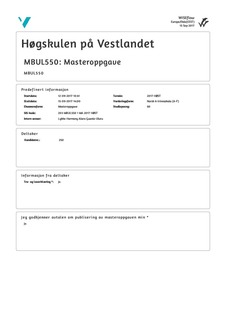| dc.contributor.advisor | Iversen, Sarah Hoem | |
| dc.contributor.advisor | Goga, Nina | |
| dc.contributor.author | Iversen, Magnus | |
| dc.date.accessioned | 2018-04-24T08:30:59Z | |
| dc.date.available | 2018-04-24T08:30:59Z | |
| dc.date.issued | 2017-09-15 | |
| dc.identifier.uri | http://hdl.handle.net/11250/2495604 | |
| dc.description | Masteroppgave i barne- og ungdomslitteratur | nb_NO |
| dc.description.abstract | I denne masteroppgaven har jeg analysert kjennetegn og funksjon ved jenter som
sekundærkarakter i de to samtidsrealistiske ungdomsromanene Natt på Frognerbadet
(Henmo, 2012) og Hvem er du, Alaska? (Green, 2014).
Teoriene jeg bruker i denne oppgaven skal bidra til å gi meg et analyseverktøy å møte
materialet mitt med. Jeg har lagt stor vekt på narrativ teori og teori om litterær analyse, støttet
på Rolf Gaaslands Fortellerens hemmeligheter – innføring i litterær analyse (1999). Svein
Slettans bok, Ungdomslitteratur – ei innføring (red.) (2014) blir også brukt for å knytte
kjennetegn og funksjon ved jentekarakterene opp mot teori om ungdomslitteraturen. Litterær
analyse – ei innføring (red.) (2012) av P.T. Andersen, Gitte Mose og Thorstein Norheim blir
også brukt for å beskrive teori om karakterer.
Jeg finner blant annet at jentene som sekundærkarakterer i de valgte ungdomsromanene kan
leses som sterke og bestemte jenter. Kjennetegnene deres står i kontrast til kjennetegnene ved
guttekarakterene som protagonister. Guttene kan leses som usikre og sårbare. Jeg finner også
at jentekarakterenes funksjon i bøkene, er å støtte opp om gutteprotagonistenes prosjekt i
handlingen. Jentekarakterene har ingen egen agenda i disse bøkene. | nb_NO |
| dc.description.abstract | In this master thesis I analyze the characteristics and functions in girls as secondary characters
in two contemporary realistic adolescent novels called Natt på Frognerbadet (Henmo, 2012)
and Hvem er du, Alaska? (Green, 2014).
The theoretical framework of this master thesis is used to give me a tool in analyzing my
material. Narrative theory and theory on literary analyzes play a big part in the thesis and I
rely on Rolf Gaaslands Fortellerens hemmeligheter – innføring i litterær analyse (1999) as
my source of information. Svein Slettans book, Ungdomslitteratur – ei innføring (red.) (2014)
is used to tie the characteristics and functions of the girl character together with theory on
adolescent literature. Litterær analyse – ei innføring (red.) (2012) by P.T. Andersen, Gitte
Mose og Thorstein Norheim is also used to describe theory on characters.
In my readings I find that girls as secondary characters in the selected adolescent novels can
be read as strong and determined girls. Their characteristics can be seen in contrast to the boy
characters as protagonists. The boys can be read as uncertain and vulnerable. I also find that
the girl characters function in the books is to support the boy protagonists project in the
action. The girl characters have no agenda of their own in these books. | nb_NO |
| dc.language.iso | nob | nb_NO |
| dc.publisher | Høgskulen på Vestlandet/ Western Norway University of Applied Sciences | nb_NO |
| dc.rights | Navngivelse 4.0 Internasjonal | * |
| dc.rights.uri | https://creativecommons.org/licenses/by/4.0/deed.no | * |
| dc.subject | Ungdomslitteratur | nb_NO |
| dc.subject | Karakterer | nb_NO |
| dc.subject | Jentekarakterer | nb_NO |
| dc.subject | Guttekarakterer | nb_NO |
| dc.subject | Sekundærkarakterer | nb_NO |
| dc.subject | Adolescent novels | nb_NO |
| dc.subject | Girl characters | nb_NO |
| dc.subject | Secondary characters | nb_NO |
| dc.title | De andre jentene i ungdomslitteraturen | nb_NO |
| dc.title.alternative | The Other Girls in Adolescent Literature | nb_NO |
| dc.type | Master thesis | nb_NO |
| dc.description.version | publishedVersion | nb_NO |
| dc.rights.holder | Magnus Iversen | nb_NO |
| dc.description.localcode | MA-BUL | nb_NO |

